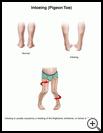
Intoeing
________________________________________________________________________
KEY POINTS
- Intoeing is a term used for toes that point inward. It is common in babies and young children. Intoeing is also called being “pigeon-toed.”
- Most children don’t need treatment. Usually intoeing gets better on its own. Special shoes usually help, or if severe, your child’s healthcare provider may put a cast on your child’s feet and lower legs.
- Follow the instructions your child’s healthcare provider gives you.
________________________________________________________________________
What is intoeing?
Intoeing is a term used for toes that point inward. It is common in babies and young children. Intoeing is also called “pigeon-toed.”
What is the cause?
Intoeing may be caused by the baby’s position in the mother’s womb before birth. It’s usually present from birth, but you may not notice it until your child starts standing and walking. Some types of intoeing may not be obvious until your child is 5 or 6 years old. Intoeing is usually caused by a twisting of the thighbone, shinbones, or bones in the foot.
How is it diagnosed?
Your healthcare provider will ask about your child's symptoms and medical history and examine your child.
How is it treated?
Most children don’t need treatment. Usually intoeing gets better on its own. When it’s caused by a shinbone that twists inward, intoeing usually gets better by about 5 years of age. If it’s caused by a thighbone twisted in at the hip, it usually gets better by about 11 years of age. Your child is likely to sit in a position that is most comfortable, and this does not make intoeing worse.
If there is a problem with one or both of your child’s feet, special shoes sometimes help. In severe cases, your child’s healthcare provider may put a cast on your child’s feet and lower legs. Casts are most often used before your child is 8 months old. Surgery is only rarely needed.
How can I take care of my child?
Follow the instructions your child’s healthcare provider gives you. Ask your provider:
- If there are activities your child should avoid and when your child can return to normal activities
- How to take care of your child at home
- What symptoms or problems you should watch for and what to do if your child has them
Make sure you know when your child should come back for a checkup.
Last modified: 2018-03-01
Last reviewed: 2018-03-01

